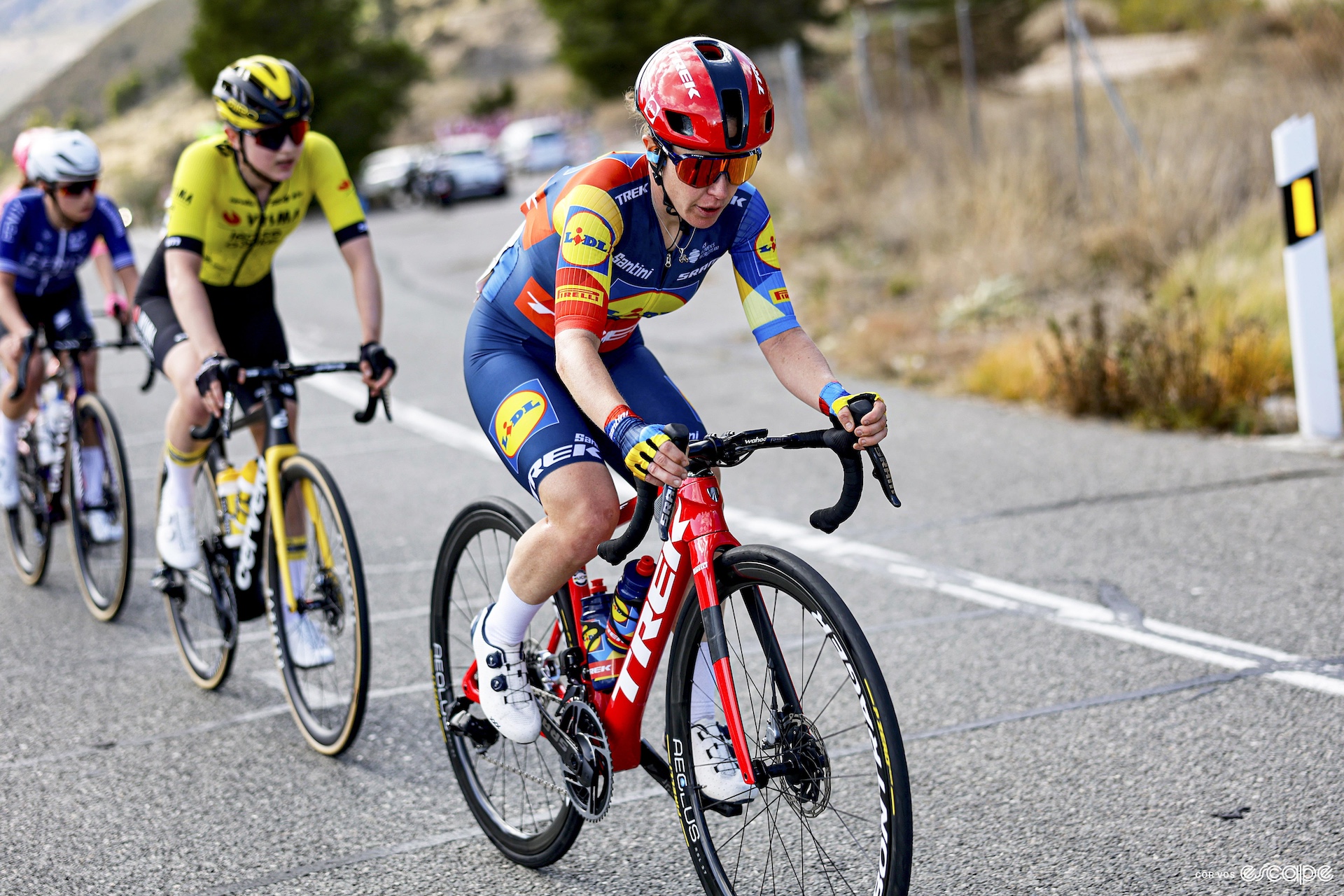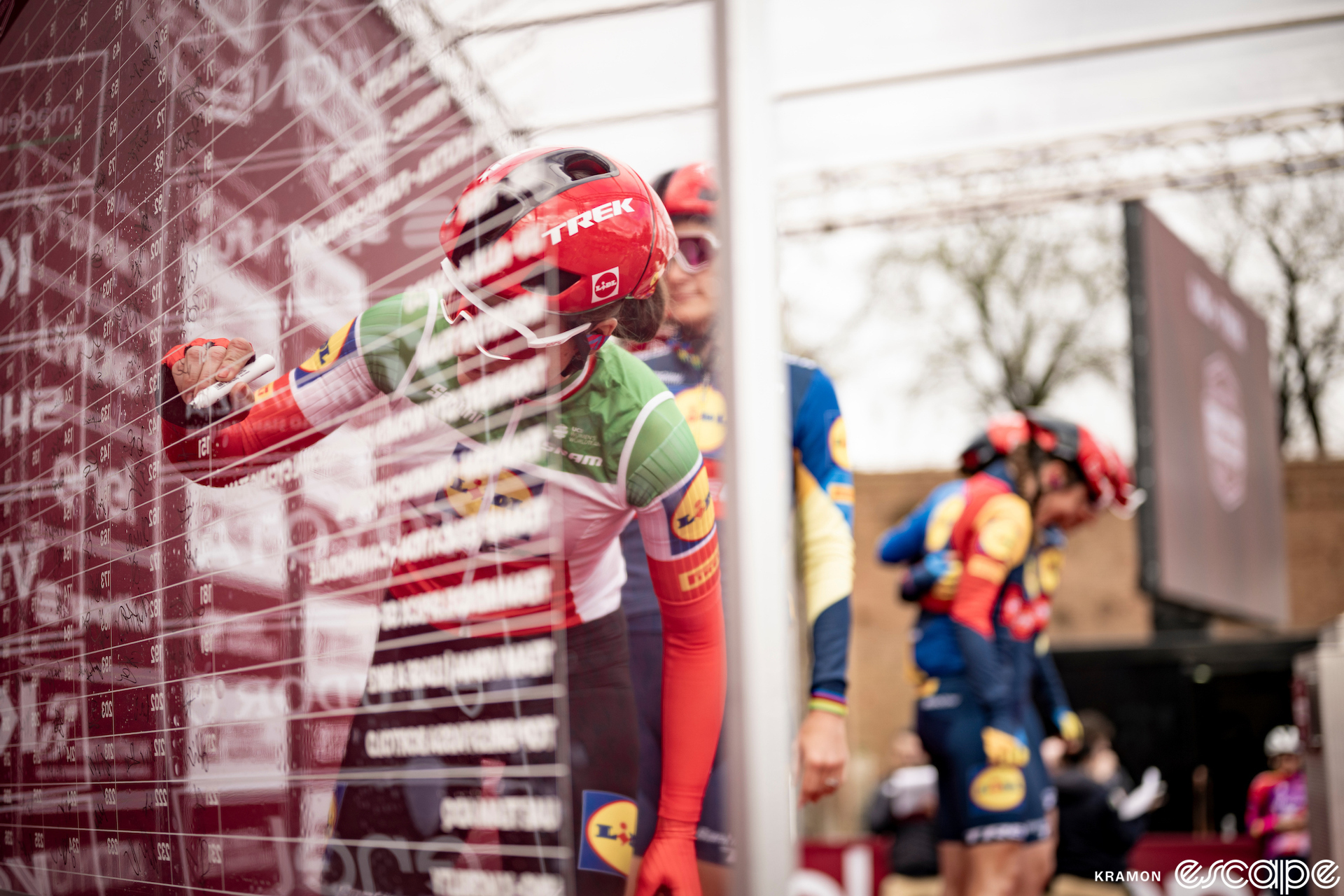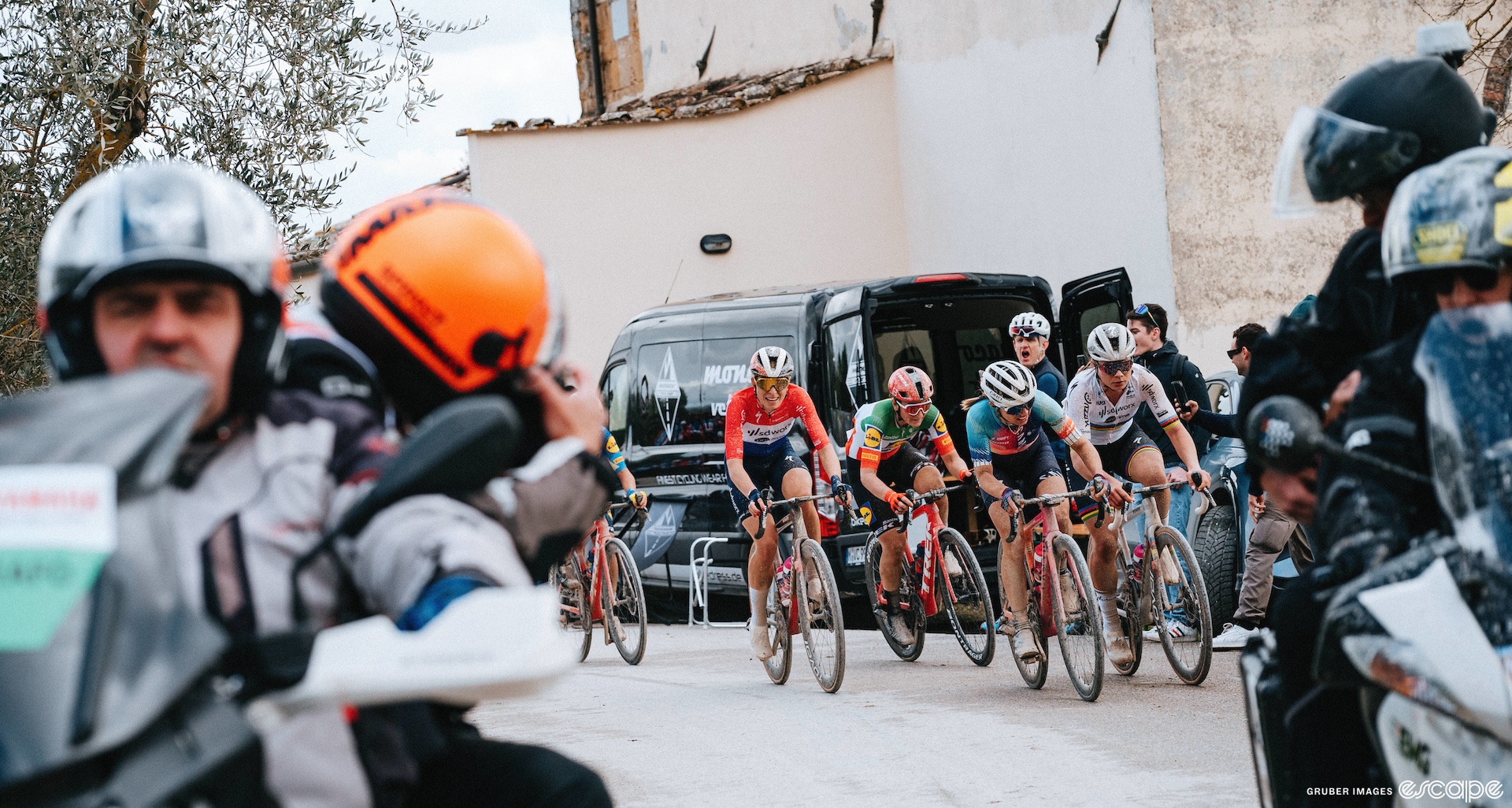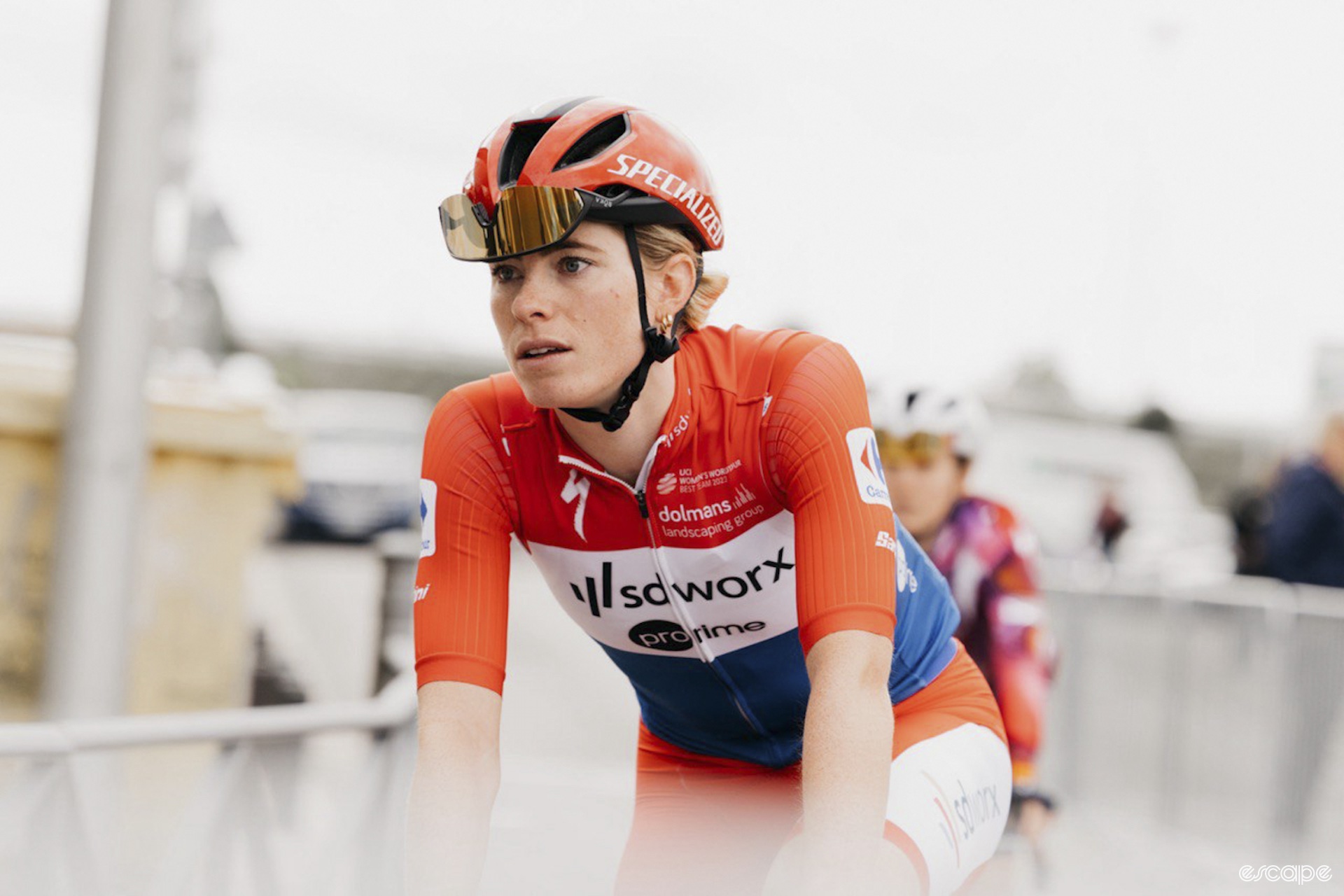Good day and thank you for reading the Wheel Talk Newsletter this week. The riders aren’t the only ones recovering from La Vuelta España Femenina, what a week of racing! But there is no time to rest, the next WorldTour stage race is already just days away – Itzulia Women. But first …
We see you Anna van der Breggen …
The former road world champion turned Director Sportif for SD Worx-Protime has been curiously absent from a number of Spring Classics, leaving the herding of cats up to Lars Boom and Danny Stam. Instead, she has been out on the (gravel) road with Geerike Schreurs who represents SD Worx-Protime on the gravel scene.
Schreurs has her own awesome story, and now that I am writing this I’m realizing I should definitely write about her. Formerly a soigneur for Lidl-Trek, Schreurs abruptly shifted gears last year to compete full-time as a professional gravel racer. She announced her signing with SD Worx-Protime in December of last year, and this season Van der Breggen has been accompanying her to the races.

She traded Strade Bianche for the Belgian Waffle Ride in Arizona, and even though some events like Paris-Roubaix Femmes have her listed as an on-the-ground DS, she wasn’t in the Roubaix Velodrome when Lotte Kopecky won. Team pictures include both Stam and Boom on the podium with the team.
In Instagram posts from riders, Van der Breggen could be seen pre-Ardennes out on shakeout rides, with Lorena Wiebes joking that the former Giro winner is still fitter than most.
Van der Breggen proved that fitness last weekend at the TRAKA, a gravel race the first weekend of May in Girona, Spain that includes distances ranging from 50 km to 360 km. Schreurs finished second in the longest event, the 360 km, and the next day Van der Breggen lined up for the 100 km ride. A few other familiar names were in attendance as well: Wiebes, Femke Markus, and more from SD Worx-Protime’s road team.
SD Worx-Protime ended up sweeping the podium in the 100 km long event and I know you’re thinking “Wiebes was one of the three,” but you’d be wrong.

Marie Schreiber won the race with Markus taking third and between the two was none other than Van der Breggen herself! Imagine lining up for an event and your director lines up next to you, your director who has won almost every major race on the calendar and is a multiple-time road world champion and Olympic gold medalist. The stress. My palms are sweaty just thinking about it. And then, despite having been out of racing for two years, she rolls in second? Iconic.
What is next on the calendar for Van der Breggen? Was this a one-off or is she plotting a return to racing, just not on the road? Inquiring minds want to know.
Racing continues…
At Itzulia Women!
We are well into stage race season; with the first “Grand Tour” behind us it’s onto the shorter races starting with Itzulia Women this weekend. The three-day race was won by Marlen Reusser last year, nearly two minutes ahead of Demi Vollering and three minutes ahead of Kasia Niewiadoma.
It was the same schedule last year, with Itzulia following La Vuelta. On that occasion, Vollering had just lost the overall to Annemiek van Vleuten at La Vuelta and went into Itzulia with a point to prove. Vollering won the first two stages, stage 1 solo and stage 2 from a reduced group. She then let Reusser get 2:38 on her on the final stage but still finished second on the stage behind her teammate.
The race was a display of strength not only from Vollering but also from Reusser and the rest of SD Worx-Protime. This year looks like it will be a bit different.
The Basics
When: Friday to Sunday, May 10 – 12
Distance: Three stages – 140 km, 104 km, and 114.9 km. All three are rouleur-esque, with no flat and no high mountains.
Live coverage: 🇬🇧🇪🇺 Discovery +/Eurosport, 🇺🇸 Peacock, 🇨🇦 FloBikes, 🇦🇺 as of writing the race is not on the SBS schedule
* Daily live coverage starts at 12:30 CET *
The Courses
Stage 1: Friday, May 10 – Vitoria-Gasteiz to Elgoibar (140 km)
The first stage starts in Vitoria-Gasteiz before the race heads north towards San Sebastian. They won’t touch the Basque city, but stick to the outskirts before the stage finish in Elgoibar. Throughout the stage, the women will race three categorized climbs, two Cat 3s and a Cat 2, but the finish comes after a long gradual uphill and very short pop to the finish.

The first categorized climb comes 37 km into the stage and is only 1.9 km long, averaging 9%. It’s a good little launch pad for attacks, but it’s more likely attacks will have been trying to go long before the ascent. With the way the Vuelta went, the start of the stage is likely to be a fast one.
The Cat 2 is the hardest climb of the stage at 4.2 km, with an average of 7.3% and a maximum of 9.3%. Once the riders have reached the top there is still 51.5 km to go, so it’s not exactly a race maker, but it is difficult enough to fracture the peloton if specific teams or riders want to take advantage.
The final climb is the longest at 7 km, but only averages 2.8% and is kind of a two-parter. There are two pitches with a little rest between the two, which impacts the average gradient. The first segment is 1.9 km long and averages 6% but has sections of over 10%. The second segment is 2 km and averages 3.9% with sections of 9%.
If any of the three climbs is going to make a difference to the finale it is this second one. It offers multiple options to attack and is long enough that if one attempt doesn’t work there’s always time to go again. Once at the top, the riders descend quickly, and at the bottom of the descent, it’s only 13 km to go.
The finish is a bit odd, with a 50-metre rise of 6% to finish off the day.

Stage 2: Saturday, May 11 – Basauri to Basauri (104 km)
There is more climbing on stage 2, with three categorized climbs, but of note are a few non-categorized climbs near the end that will massively impact the finish.
The 104 km stage starts and finishes in Basauri, just southeast of Bilbao. The stage is relentless; even if none of the climbs is massive, since it’s a short stage they will be raced harder and feel more challenging at the moment. The first climb is early in the stage, it starts only 14.5 km into the stage. At only 2.9 km and 3.5% average it’s nothing insane, but watch out for anyone who decides to warm up on a trainer. The second Cat 3 climb starts 23 km later and lasts 4.1 km with an average of 5.7% and maximum grades of 9.3%. It’s a good one to split the peloton, especially because it is followed 15 km later by the only Cat 2 of the day.

This final categorized climb starts with 44 km left to race, lasts only 1.6 km, but boasts a staggering average of 10%. It’s also not that straightforward, with some little uncategorized climbs before and after.
Off the back of the Cat 2, the road is as calm as it will be all day for 20 km before a series of uncategorized climbs in the final 5 km. First, there is a 700-metre long ascent of 9%, followed by an 800 metre climb with 9% slopes, and finally a 280-metre climb of 10.8%. These three tiny climbs are all at the crunch point of the final 5 km, right before the finish.

The final 2 km of the second stage is also constant motion, with a final 500 metres that includes 8% grades. The whole day is just wild, there is so much that can happen on this course. It’s almost like a Spring Classic: a race of attrition but also a race for the teams with numbers.
Stage 3: Sunday, May 12 – Donostia to Donostia (114.9 km)
Another hilly stage awaits the women in San Sebastian for the final day, with three categorized climbs but a flat run to the line. This stage is the only one that includes a Cat 1 climb, and like the two before it, there are also a bunch of uncategorized ascents to keep in mind.
From the start, there are four uncategorized climbs: a 1.6 km ascent averaging 2% but with 13% thrown in, a 2.9 km, 4.7% average with slopes of 9%, a 1.4 km, 6% average with 15% max, and finally a 1.6 km, 3.8% average ascent – all within the first 30 km. That would make any breakaway attempt more interesting.

The first categorized climb of the race is the hardest, a 7.9 km long ascent of the Jaizkibel (used in the men’s Klasikoa San Sebastian) that averages 5% but reaches 16% in places. It’s early in the stage and tops out with 72 km remaining in the stage, but by the top, it will likely be a select group of riders in front. That’s not to say riders won’t catch back on when the road descends, and the next climb isn’t for a while. The Cat 3 is 15 km later but is only 2.7 km of 5.2%. From there it’s a further 21 km to the base of the Cat 2 that lasts 4.1 km and averages 7.3%.
From the top of the final categorized climb, there is 28.5 km to go to the flat finish.
Riders to watch
Early start lists include La Vuelta winner Demi Vollering, who will be continuing her takeover of Spain at Itzulia alongside last year’s winner Marlen Reusser. The Swiss national champion is on the comeback from her crash at the Tour of Flanders, so it probably won’t be as dominant a performance, but we could see the team free Mischa Bredewold for a stage or two. There are also opportunities for Niamh Fisher-Black to have a go at a stage, perhaps the second stage.

The next-strongest team is Canyon-SRAM, who have Ricarda Bauernfeind listed alongside Elise Chabbey. Chabbey is perfect for this race. She’s had a bit of a rest after the spring, and she will come in with climbing strength but also the guts to try something crazy. Kasia Niewiadoma is also listed on the preliminary start list, but as she went home from La Vuelta sick less than a week ago, that seems unlikely.
La Vuelta stage winner Évita Muzic (FDJ-Suez) is coming in with all the confidence in the world, and with Loes Adegeest who could slip into some moves.
As for Lidl-Trek, Amanda Spratt will be joined by the young kids including Shirin van Anrooij, another rider coming off a little rest.

One of the standout riders at last year’s race was Canadian Olivia Baril, who will return this year for Movistar, alongside Arlenis Sierra.
Liv AlUla Jayco’s Ingvild Gåskjenn was fantastic at La Vuelta, after a strong Ardennes campaign, and it would be great to see that form continue in Itzulia.
While writing none of the teams have officially released their rosters, so the above are based on preliminary startlists and subject to change. UAE Team ADQ, Visma-Lease a Bike, Uno-X, Human Powered Health, and AG Insurance-Soudal are not racing.
Wheel Talk Podcast
It was another long one this week but Loren, Gracie, and I had much to discuss after this year’s La Vuelta! From Vollering’s strength to FDJ-Suez’s joy, with audio diaries from Maike van der Duin of Canyon-SRAM, Brodie Chapman of Lidl-Trek, Kim Cadzow of EF Education-Cannondale, Alessia Vigilia of FDJ-Suez, and Georgia Baker of Liv AlUla Jayco.
Let’s Discuss
Milan-San Remo Donne?
It feels like once a year a rumour starts to make its way around cycling that RCS is going to add a women’s Milan-San Remo to the calendar. Usually, it’s around the race, in the weeks before the men’s, but this year the rumour came late.
The early-season classic remains one of two Monuments without a women’s edition, along with Il Lombardia in the Fall. According to RCS, which promotes both races, they are hoping to rectify that by 2025, but there are a few hurdles. The main one is the standalone women’s event that takes place the day before the men race 288 km from Milan to San Remo: Trofeo Alfredo Binda.

Trofeo Alfredo Binda is one of the longer-running races on the women’s side and one of the few spring one-days that isn’t attached to a men’s event. In recent years it has been won by Marianne Vos, Elisa Balsamo, Elisa Longo Borhgini, and Kasia Niewiadoma, and normally it takes place on Sunday, the day after Milan-San Remo.
Apparently, talks are ongoing between RCS and the organizers of Trofeo Alfredo Binda to move the established race to another weekend on the calendar. RCS has only recently become more interested in the women’s side of the sport; the first race they added was Strade Bianche, then last year the UAE Tour, and this year they will take control of the women’s Giro.
Both Lotte Kopecky and (last year) Lizzie Deignan have expressed interest in a women’s Milan-San Remo.

The race would likely start in Genoa and run between 130 and 180 km in length but include the same iconic finishing climbs the Poggio and Cipressa.
On the one hand, another Monument for the women would be great. On the other, it goes against what I wrote about a few weeks ago, that women’s cycling will come to a point where it needs to step out from under the shadow of the men’s side of the sport.
If, hypothetically, the calendar moved Ronde van Drenthe so that we had Strade Bianche, Binda, and Milan-San Remo back-to-back, it would help solve the problem of asking teams to travel from opening weekend in Belgium to Italy back to the Netherlands and then back to Italy.
What do you think? Should the women get a Milan-San Remo? Or maybe there’s a way Trofeo Alfredo Binda can still fill that spot. Let me know in the comments.
The joys of social media
A video of Kasia Niewiadoma congratulating her teammates on their efforts after the Vuelta’s opening TTT was one of the best things on the internet last week, and even from home, she was quick to cheer for her team at La Vuelta. But we also need to have a moment for Ricarda Bauerneind and Antonia Niedermaier.
Canyon-SRAM came to the race with Niewiadoma as one of the red jersey hopefuls and ended up rolling up to the start line two riders short, with Neve Bradbury a DNS even before the first stage. When Niewiadoma left after stage 5 the team was down to four, with the two Germans, Zoe Bäckstedt riding her first Grand Tour, and Maike van der Duin. Bäckstedt said after the race that it wasn’t easy, she too was battling illness, but she was motivated for her teammates. Overall the team may have flown under the radar, but for Bauernfeind to finish sixth overall was pretty impressive from a small but mighty team.
A photo worth a couple of words
Even the races normally decided by crosswinds like Classic Brugge-De Panne and Ronde van Drenthe were crosswind-less this Spring so imagine our surprise when we got not one but two crosswind stages at La Vuelta!

This photo is really stunning, with the peloton in the midst of shattering and an oncoming storm. It’s the calm before the sh** hits the fan.
And finally … Taylor Swift
Yes, I am still listening to the Tortured Poets Department nonstop. Yes, it is taking a toll, but it’s a toll I’m willing to pay.
Want to hear all about it? Tune in to this week’s Album Files Podcast with myself, Matt de Neef and Iain Treloar. Find our ‘music club’ podcast everywhere podcasts are found.
Until next time!
A final note to close the newsletter. I wrote a piece on how good the racing has been so far this year, and I’d like to say that women’s cycling has always been good. We’ve had highs and lows like any other sport, and there were some seriously talented women back in the day, but the huge difference now is that the racing is live. We can actually watch the finales of races. It is a massive part of the boom we are having now.
Finally, some great news to finish off. Cecilie Uttrup Ludwig will be back in the peloton soon!
Thank you so much for reading this week’s Wheel Talk newsletter. I will return next week, but in the meantime, if you have any thoughts on future Discussions you can find me on the Escape Collective Discord.
Did we do a good job with this story?


